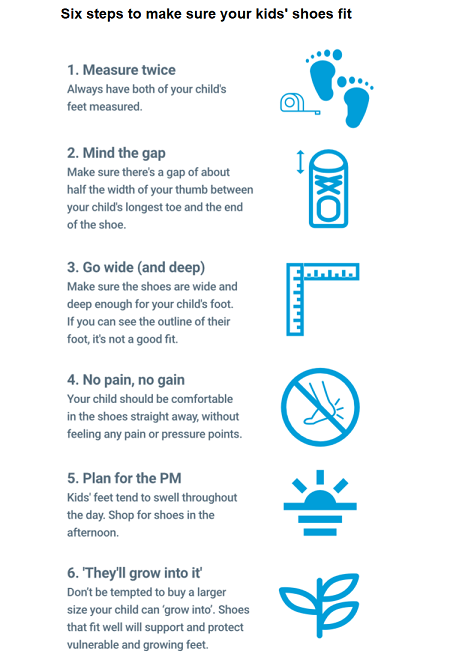Why is it so important for school shoes to fit properly?
The bones in young children's feet don't fuse together until puberty. Kids' feet can lack muscle strength and be prone to hypermobility, so firm, supportive shoes help protect their feet while they're growing.
"A good school shoe provides a stable home for immature bones," says Charlotte Bodell, a podiatrist and spokesperson for the Australian Podiatry Association. "Without that support, children are in danger of developing flat feet, sore knees, shin splints and even back pain. A good shoe that fits properly is important."
Kids' feet grow quickly and can change shape as well as size. Experts recommend doing a size check at these intervals:
- One to three months up to the age of three.
- Every four months up to the age of five.
- Every six months until your child stops growing completely.

What to look for
"The best kind of school shoes should be supportive, durable and comfortable with a good gripping sole," says Bodell. Here's what you should look for:
- Flexibility in the front. Pick up the shoe and try to bend it by pushing the toe upwards. A good shoe will bend at the ball of the foot but no further. This helps your child 'push off' with their toes while keeping the back half of their foot stable and secure.
- ...but not too much flexibility. Shoes that bend all over or are easily twisted don't provide enough support.
- A good school shoe will have a small heel. While this may sound counterintuitive, a low heel keeps your child's foot in a neutral position. An entirely flat shoe can cause your child's toes to 'claw' when walking.
- Not too heavy. Heavy shoes can mean muscle pain and foot aches, especially for little people.
- Plenty of toe room. Check that your child can wiggle their toes and that the 'toe box' (the empty space at the end of the shoe) is deep.
- Leather uppers last longer and allow your child's feet to breathe.
- The sock liner or insole should be soft, comfortable and made of an absorbent fabric to reduce sweating. You should be able to remove it easily; in case you need to replace it with an orthotic.
- Shoelaces, buckles and Velcro are all equally good, but avoid slip-on shoes that can't be adjusted.
When is it time for new shoes?
- When toes are touching the end it's time to size up.
- When the tread on the bottom of the shoe has worn away, as they can be too slippery.
- Lots of wear on the side or scuff marks may mean the shoe is too tight.
- When there are holes in the toes, or the heels are worn down badly.
Shoe clues – spotting problems with your child's feet
A school shoe can indicate if your child is having issues with their gait or if they need to be assessed by a podiatrist. Here are some things to watch out for:
- If the shoe is worn down unevenly, this could mean your child has a mechanical imbalance in their foot and may need orthotics.
- If your child's big toe is coming through the top of the shoe, they could be hyper-extending their toes as there isn't enough arch support.
